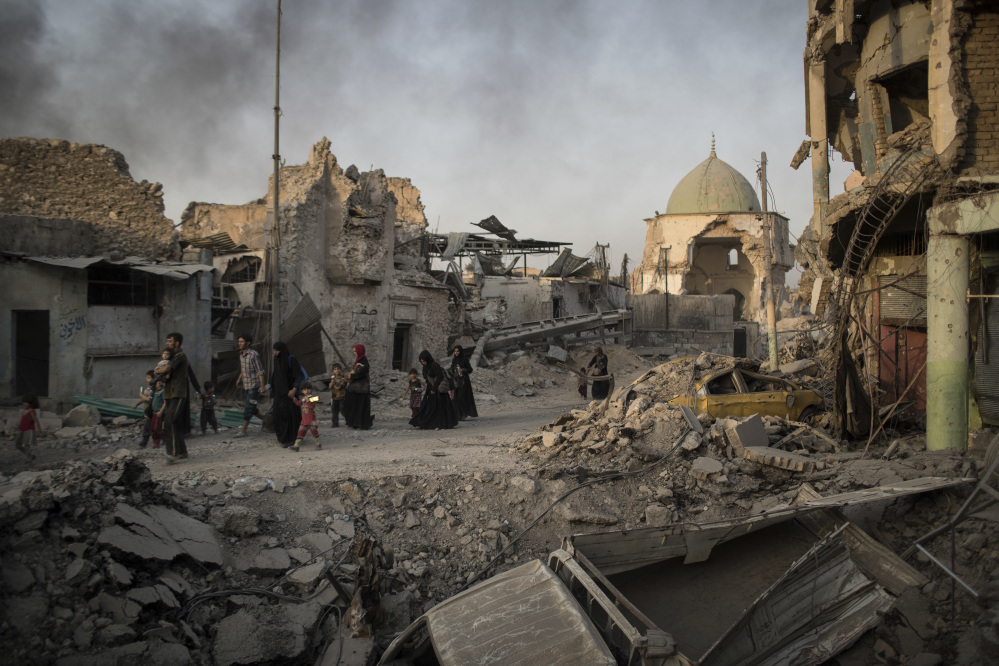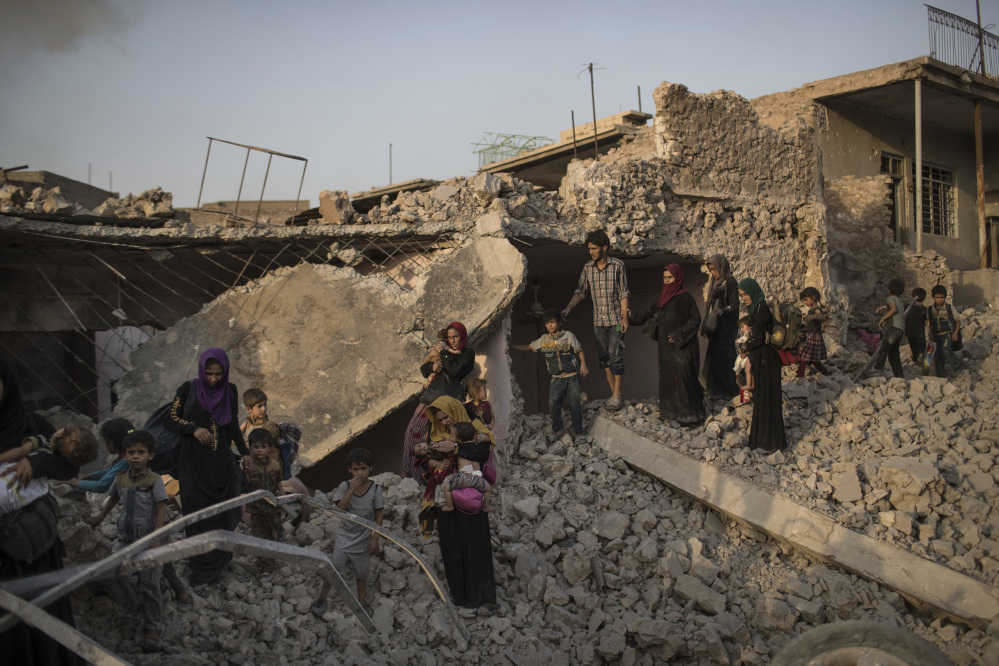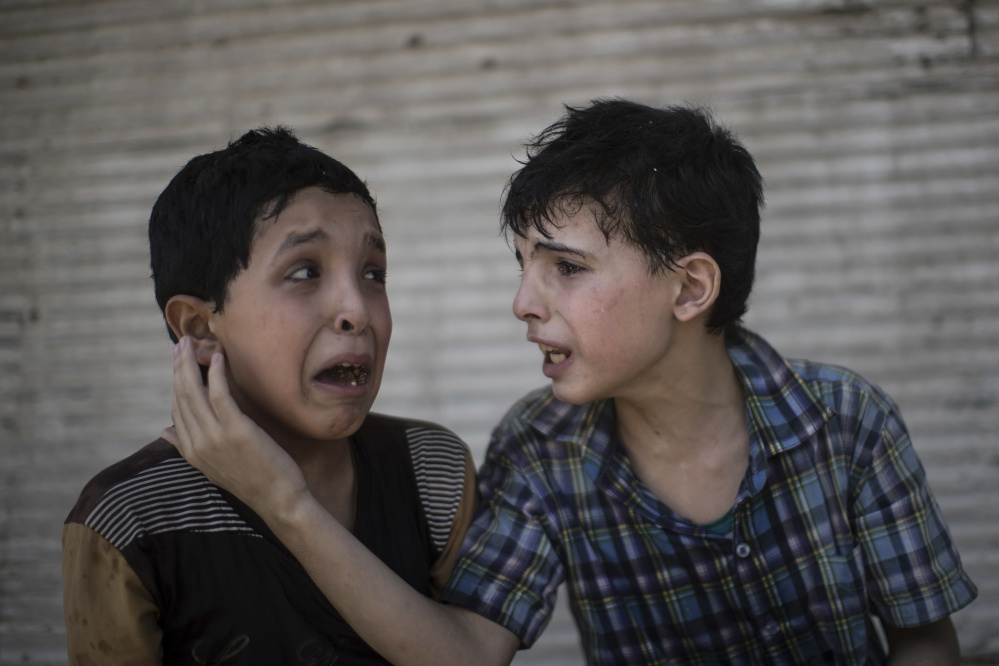MOSUL, Iraq — There was a smell of death in Mosul’s Old City when Ayman Hashem came back last week to see what happened to his home. His neighborhood was unrecognizable.
“All that’s left is rubble and the bodies of families trapped underneath,” the 23-year-old said. He flipped through photos on his phone, showing picture after picture of wreckage. His own house was “cut in half,” he said. He had to cover his nose with his T-shirt because of the smell of buried, rotting bodies.
Iraq’s U.S.-backed forces wrested Mosul from the Islamic State group at the cost of enormous destruction. The 9-month fight culminated with a crescendo of devastation – the blasting of the historic Old City to root out the deeply dug-in militants.
Nearly a third of the Old City – more than 5,000 buildings – was damaged or destroyed in the final three weeks of bombardment up to July 8, according to a survey by U.N. Habitat using satellite imagery. Across the city, 10,000 buildings were damaged over the course of the war, the large majority in western Mosul, the scene of the most intense artillery, airstrikes and fighting during the past five months. The survey only covers damage visible in satellite photos, meaning the real number is likely higher.
EXTREMIST THREAT REMAINS
The population, once numbering 3 million, is battered and exhausted, with hundreds of thousands displaced. Without a swift campaign to rebuild Mosul, aid and rights groups warn the current humanitarian crisis will balloon and resentment will likely give way to extremism, undermining the victory.
“If the western half is ignored it will produce a social disaster and this social disaster will create bigger destruction if it’s not addressed,” said Khatab Mohammed al-Najjar, a resident of eastern Mosul who watched the Old City burn from across the Tigris River during the operation.
“West Mosul produced Daesh, and it is very possible it may produce a new Daesh,” he said, referring to west Mosul’s historically more religious and traditional residents. He used the Arabic acronym for the Islamic State.
When Iraqi Prime Minister Haider al-Abadi declared victory in Mosul Monday, he pledged reconstruction. But his government still struggles to finance day-to-day workings of the state amid low oil prices.
Thousands of Mosul families have been left without a home. Schools have been leveled, utility grids wrecked, highways pounded into broken dirt roads.
All five of the city’s bridges spanning the Tigris River have been damaged. The main hospital complex where a battle raged for more than a month is a burned-out shell. Mosul’s airport looks like a derelict parking lot, booby-trapped with explosives by fleeing Islamic State fighters.
In eastern Mosul, the destruction was less intense. More than 160,000 of the 176,000 people who fled the east have returned, according to the U.N. Residents have begun rebuilding homes, and shops have reopened.
But west of the Tigris, neighborhoods have been rendered into ghost towns. There, coalition strikes killed some 5,805 civilians between Feb. 19 and June 19, according to Airwars, a London-based monitoring group tracking civilian deaths resulting from coalition actions.
Fewer than a tenth of the 730,000 people who fled western Mosul have filtered back.
Saif Mohammed recently re-opened his sandwich shop on a main avenue in the west, repairing war damage with the help of a $5,000 loan from relatives. On the same street, only two or three other shops are open. The other storefronts are bombed out and burned,.
His shop is a bet that residents will return. “But what people really need is government help,” he said. “If the government doesn’t give money, there won’t be any rebuilding.”
SOME FAULT GOVERNMENT
Hiyam Mohammed hid in her home with her family on the edge of the Old City throughout the fight. They could see the cemetery from their house.
“Some days the funerals lasted from dawn into the night. There were so many bodies piled up, it looked like a hill,” she said.
She said the only way to justice is if the government and coalition pay compensation to those who lost relatives or property.
“The government brought Daesh to us,” she said, referring to sectarian rule that fueled Sunni extremism and corruption that weakened the country’s security forces. “This mess is God’s revenge for that.”
But some in the security forces have resentments of their own, blaming Mosul residents for supporting the Islamic State.
“The people here have always had a rebellious nature, so they should take some responsibility for what has happened,” said Maj. Imad Hassan, a federal police officer from Baghdad.
During the campaign, his unit fought to capture a stretch of the corniche running along the Tigris, hammering it with artillery for weeks to clear out resistance. The former municipal center was shredded.
“I hope this destruction teaches them their lesson,” he said.
Iraqi and coalition officials say the devastation was the result of the Islamic State group’s tenacious grip. The militants transformed the city into a fortress. Its fighters used hospitals and schools as military bases, moved civilians from the rural outskirts into central neighborhoods to use as shields from airstrikes and rigged hundreds of houses and roads with explosives.
Nearly 10 years ago, Maj. Maher Aziz Khalaf fought the Islamic State’s predecessor, al-Qaida, in Mosul alongside U.S. forces. But when he rolled into western Mosul in early February he said he immediately realized this battle would alter the city in a way previous fights hadn’t.
“In 2008 it was different,” he said. “We were fighting gangs, not an entire city.”
Send questions/comments to the editors.





Success. Please wait for the page to reload. If the page does not reload within 5 seconds, please refresh the page.
Enter your email and password to access comments.
Hi, to comment on stories you must . This profile is in addition to your subscription and website login.
Already have a commenting profile? .
Invalid username/password.
Please check your email to confirm and complete your registration.
Only subscribers are eligible to post comments. Please subscribe or login first for digital access. Here’s why.
Use the form below to reset your password. When you've submitted your account email, we will send an email with a reset code.